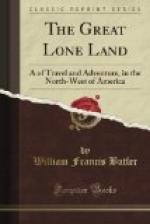CHAPTER TWENTY.
The Buffalo—His Limits and favourite Grounds—Modes of Hunting—A Fight —His inevitable End—I become a Medicine-man—Great Cold-Carlton—Family Responsibilities.
When the early Spanish adventurers penetrated from the sea-board of America into the great central prairie region, they beheld for the first time a strange animal whose countless numbers covered the face of the country. When De Soto had been buried in the dark waters of the Mississippi, the remnant of his band, pursuing their western way, entered the “Country of the Wild Cows.” When in the same year explorers pushed their way northward from Mexico into the region of the Rio-del-Norte, they looked over immense plains black with moving beasts. Nearly 100 years later settlers on the coasts of New England heard from westward-hailing Indians of huge beasts on the shores of a great lake not many days journey to the north-west. Naturalists in Europe, hearing of the new animal, named it the bison; but the colonists united in calling it the buffalo, and, as is usual in such cases, although science clearly demonstrated that it was a bison, and was not a buffalo, scientific knowledge had not a chance against practical ignorance, and “buffalo” carried the day. The true home of this animal lay in the great prairie region between the Rocky Mountains, the Mississippi, the Texan forest, and the Saskatchewan River and although undoubted evidence exists to show that at some period the buffalo reached in his vast migrations the shores of the Pacific and the Atlantic; yet since the party of De Soto only entered the Country of the Wild Cows after they had crossed the Mississippi, it may fairly be inferred that the Ohio River and the lower Mississippi formed the eastern boundaries to the wanderings of the herds since the New World has been known to the white man. Still even within this immense region, a region not less than 1,000,000 of square miles in area, the havoc worked by the European has been terrible. Faster even than the decay of the Indian has gone on the destruction-of the bison and only a few years must elapse before this noble beast, hunted down in the last recesses of his breeding-grounds, will have taken his place in the long list of those extinct giants which once dwelt in our world. Many favourite




